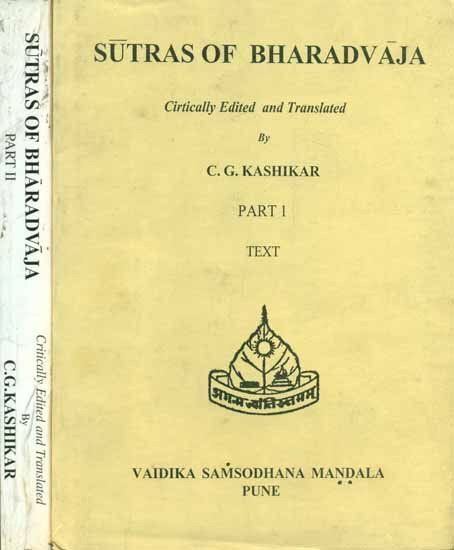Bharadvaja-srauta-sutra
by C. G. Kashikar | 1964 | 166,530 words
The English translation of the Bharadvaja-Srauta-Sutra, representing some of the oldest texts on Hindu rituals and rites of passages, dating to at least the 1st millennium BCE. The term Srautasutra refers to a class of Sanskrit Sutra literature dealing with ceremonies based on the Brahmana divisions of the Veda (Sruti). They include Vedic rituals r...
Praśna 5, Kaṇḍikā 6
1. The Adhvaryu should remove the ashes of the Brāhmaudanika fire, join together the two kindling woods with the daśahotṛ formula, and while a horse is standing nearby, he should churn out the fire with the formula, “O Agni, do thou be generated together with Agni, wealth, abundance, offspring, cattle, and Brahman-splendour.”[1]
2. While the fire is being churned out, he should cause the sacrificer to recite the caturhotṛ formula.
3. As soon as the fire is generated, the sacrificer should give a boon[2] to the Adhvaryu.”[3]
4. He should breathe out on the fire, which has been generated, with the formula, “I breathe out upon thee with the breathe of Prajāpati.”
5. He should then receive the fire by means of both his hands with the verse, “The mortals have generated the immortal, faultless, quick firm-jawed. Let the ten sisters, the fingers, true ones, seize the generated man.”[4]
6. Then he should carry it forth towards the east, and, being seated, set up the Gārhapatya fire upon the substances while the sun has not yet risen and while the Rathantara Sāman is being chanted.
7. He should set up the Gārhapatya fire of a (Brāhmaṇa) sacrificer belonging to Bhṛgu gotra with the formula, “O, lord of vows, I set thee with the vow of the Bhṛgus;” of a (Brāhmaṇa) sacrificer belonging to the Aṅgiras gotra with the formula, “O lord of vows, I set thee with the vow of the Aṅgirases;” of other Brāhmaṇa sacrificers with the formula, “O lord of vows, I set thee with the vow of the Ādityas;” of a king with the formula, “O lord of vows, I set thee with the vow of Varuṇa;” of a Rājanya with the formula, “O lord of vows, I set thee with the vow of Indra;” of a Vaiśya with the formula, “O lord of vows, I set thee with the vow of Manu, the chief of community;” of a Rathakāra with the formula, “O lord of vows, I set thee with the vow of the gods Ṛbhus.”[5]
8. He should deposit all the fires on the substances themselves.
Footnotes and references:
[2]:
By a boon Āpastamba-śrauta-sūtra V.11.4 means a cow or a milch cow or a bullockcart or a heifer.
[3]:
[4]:
Taittirīya-brāhmaṇa I.24.19.
[5]:
Taittirīya-brāhmaṇa I.1.4.8.
